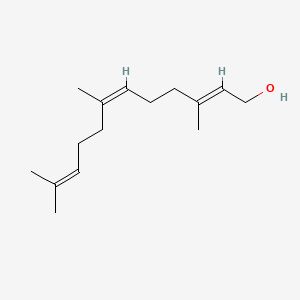(e,z)-farnesol
(e,z)-farnesol is a lipid of Prenol Lipids (PR) class.
Cross Reference
There are no associated biomedical information in the current reference collection.
Current reference collection contains 3613 references associated with (e,z)-farnesol in LipidPedia. Due to lack of full text of references or no associated biomedical terms are recognized in our current text-mining method, we cannot extract any biomedical terms related to diseases, pathways, locations, functions, genes, lipids, and animal models from the associated reference collection.
Users can download the reference list at the bottom of this page and read the reference manually to find out biomedical information.
Here are additional resources we collected from PubChem and MeSH for (e,z)-farnesol
Possible diseases from mapped MeSH terms on references
We collected disease MeSH terms mapped to the references associated with (e,z)-farnesol
PubChem Biomolecular Interactions and Pathways
All references with (e,z)-farnesol
Download all related citations| Authors | Title | Published | Journal | PubMed Link |
|---|---|---|---|---|
| Shipman CM et al. | The bisphosphonate incadronate (YM175) causes apoptosis of human myeloma cells in vitro by inhibiting the mevalonate pathway. | 1998 | Cancer Res. | pmid:9850051 |
| Blum R et al. | Ras inhibition in glioblastoma down-regulates hypoxia-inducible factor-1alpha, causing glycolysis shutdown and cell death. | 2005 | Cancer Res. | pmid:15705901 |
| Eskens FA et al. | Farnesyl transferase inhibitors: current developments and future perspectives. | 2000 | Cancer Treat. Rev. | pmid:11006134 |
| Ong TP et al. | Farnesol and geraniol chemopreventive activities during the initial phases of hepatocarcinogenesis involve similar actions on cell proliferation and DNA damage, but distinct actions on apoptosis, plasma cholesterol and HMGCoA reductase. | 2006 | Carcinogenesis | pmid:16332721 |
| Szűcs G et al. | Cardioprotection by farnesol: role of the mevalonate pathway. | 2013 | Cardiovasc Drugs Ther | pmid:23673412 |
| Pando R et al. | The Ras antagonist farnesylthiosalicylic acid ameliorates experimental myocarditis in the rat. | 2010 Mar-Apr | Cardiovasc. Pathol. | pmid:19144546 |
| RodrÃguez C et al. | Statins normalize vascular lysyl oxidase down-regulation induced by proatherogenic risk factors. | 2009 | Cardiovasc. Res. | pmid:19406911 |
| Yoo S et al. | Antimicrobial traits of tea- and cranberry-derived polyphenols against Streptococcus mutans. | 2011 | Caries Res. | pmid:21720161 |
| Søgaard M et al. | A rab protein is required for the assembly of SNARE complexes in the docking of transport vesicles. | 1994 | Cell | pmid:7923363 |
| Aronheim A et al. | Membrane targeting of the nucleotide exchange factor Sos is sufficient for activating the Ras signaling pathway. | 1994 | Cell | pmid:7923364 |
| Forman BM et al. | Identification of a nuclear receptor that is activated by farnesol metabolites. | 1995 | Cell | pmid:7774010 |
| Zoccarato F et al. | The adenosine inhibition of glutamate exocytosis in synaptosomes is removed by the collapse of the vesicle-cytosol deltapH plus the opening of farnesol-sensitive Ca(2+) channels. | 2003 | Cell Calcium | pmid:12618148 |
| Shapira S et al. | The tumor suppressor neurofibromin confers sensitivity to apoptosis by Ras-dependent and Ras-independent pathways. | 2007 | Cell Death Differ. | pmid:17096025 |
| Amos S et al. | Farnesylthiosalicylic acid induces caspase activation and apoptosis in glioblastoma cells. | 2006 | Cell Death Differ. | pmid:16239932 |
| Shalom-Feuerstein R et al. | Restoration of sensitivity to anoikis in Ras-transformed rat intestinal epithelial cells by a Ras inhibitor. | 2004 | Cell Death Differ. | pmid:14576773 |
| Goldberg L et al. | FTS and 2-DG induce pancreatic cancer cell death and tumor shrinkage in mice. | 2012 | Cell Death Dis | pmid:22419113 |
| Charette N et al. | Salirasib sensitizes hepatocarcinoma cells to TRAIL-induced apoptosis through DR5 and survivin-dependent mechanisms. | 2013 | Cell Death Dis | pmid:23348585 |
| Makovski V et al. | Analysis of gene expression array in TSC2-deficient AML cells reveals IRF7 as a pivotal factor in the Rheb/mTOR pathway. | 2014 | Cell Death Dis | pmid:25476905 |
| Okamoto S et al. | Zoledronic acid induces apoptosis and S-phase arrest in mesothelioma through inhibiting Rab family proteins and topoisomerase II actions. | 2014 | Cell Death Dis | pmid:25393473 |
| Lee J et al. | Proto-oncogenic H-Ras, K-Ras, and N-Ras are involved in muscle differentiation via phosphatidylinositol 3-kinase. | 2010 | Cell Res. | pmid:20603646 |
